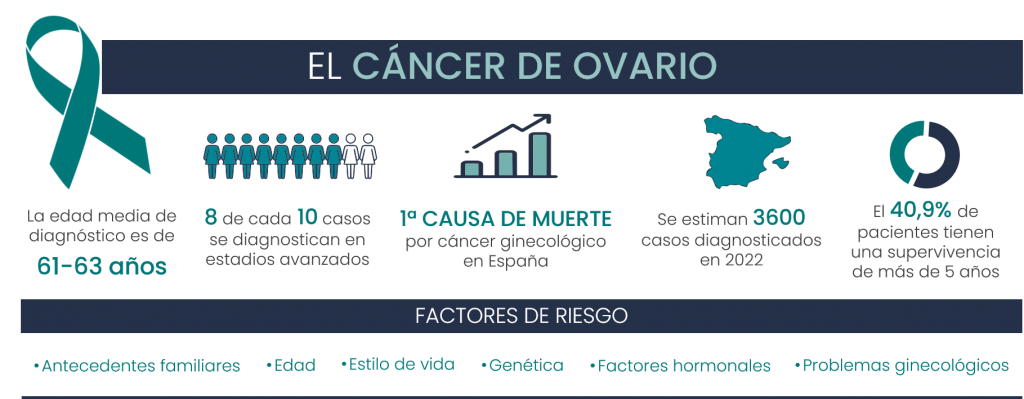May 8 is World Ovarian Cancer Day.
It is estimated that ovarian cancer will affect 3,600 women in Spain in 2022. Despite representing only 3% of all female tumors, it is the fourth leading cause of death from cancer in women and the leading cause of mortality from gynecological cancer. This high mortality is due to the late diagnosis of the disease in most patients (70-80%). This delay in diagnosis is explained by the absence of specific symptoms at the onset of the disease and the lack of effective early detection methods. Survival at 5 years from diagnosis stands at 40.9% of patients. However, it increases to 94% when the diagnosis is made at an early stage, which underlines the importance of being able to establish an early diagnosis.

The clinical diagnosis of ovarian cancer is made by a thorough and complete evaluation of the patient, including clinical history, gynecologic examination, blood tests and imaging tests, such as gynecologic ultrasound or CT of the abdomen and pelvis. The definitive diagnosis of ovarian cancer is established after the anatomopathological study of the tumor in a biopsy of the tumor. There are 3 types of ovarian cancer, epithelial carcinoma being the most frequent of all, accounting for 85-90% of cases. Germ cell tumor and stromal tumor are much less frequent.
The causes of ovarian cancer are still not fully understood, although, like other types of tumors, it is the accumulation of mutations in the DNA that gives rise to uncontrolled cell growth. Approximately 80% of cases of ovarian cancer are sporadic, i.e. the mutations are acquired throughout life, are not inherited and are present only in certain cells of the ovary. In these cases, mutations frequently appear in the TP53 gene, a tumor suppressor gene that is mutated in more than 50% of all human cancers and which codes for a multifunctional protein whose deficiency contributes to the accumulation of mutations and to the acceleration of tumor development. About 20% of ovarian cancers are hereditary, that is, they are caused by mutations that are transmitted within a family.
Hereditary ovarian cancer
In hereditary ovarian cancer, 65-85% of mutations are found in the BRCA1 and BRCA2 genes, although other ovarian cancer-associated genes such as RAD51C, RAD51D and BRIP1 have also been described. These genes form part of the group of tumour suppressor genes and contain the information for the production of proteins involved in DNA repair and, therefore, in the maintenance of an intact genome. When these genes are altered they cannot perform their function correctly, they cannot repair the DNA, so alterations accumulate and lead to uncontrolled cell growth resulting in tumour development. It is important to note that not all women with BRCA1 or BRCA2 mutations will develop ovarian cancer, but their risk of developing ovarian cancer is increased.
A significantly increased risk of ovarian cancer is also observed in patients with Lynch syndrome. This syndrome is most often associated with mutations in the MLH1 or MSH2 genes, and accounts for 10% to 15% of all hereditary ovarian cancers. In addition to ovarian cancer, mutations in these genes increase the risk of other types of cancer.
When hereditary ovarian cancer is suspected, a genetic study is recommended to identify the familial mutation causing the pathology.
Genetic diagnosis process in hereditary ovarian cancer
The performance of the genetic study follows a series of steps which are summarised below:
- The Genetics Unit carries out a consultation of Genetic Counseling where the patient is advised to undergo a genetic study. In this first consultation we also explain what the study consists of, as well as its implications.
- The study is performed on the basis of a blood sample. After obtaining the sample, DNA is extracted from the blood cells and the genes of interest associated with the disease are sequenced. In this case BRCA1, BRCA2, MMR genes, RAD51C, RAD51D and BRIP1, among others.
- The team of geneticists then interprets the changes found in the genes studied and prepares the results report.
- In a second Genetic Counselling consultation, geneticists and/or oncologists explain to the patient the results obtained and the recommendations to be followed.
The performance of a genetic study is of vital importance since knowing the presence of mutations associated with the development of the disease allows a more exhaustive clinical follow-up of patients by performing gynecological studies every 6 to 12 months, taking preventive actions such as chemoprevention with oral contraceptives or reduction surgery and identifying other family members at risk.
Importance of ovarian cancer research
Research into the genetic basis of ovarian cancer is essential to be able to identify patients and relatives at high risk of developing the disease.
In recent years, some studies have identified the SMARCA4 gene as a causal gene for hypercalcemic small cell ovarian cancer, a rare but very aggressive type of cancer that is difficult to diagnose and can appear at an early age. Dr. Foulkes' team is investigating variants found in SMARCA4 to find out which pathogenic mutations lead to an increased risk of developing this type of cancer. This and other research will make it possible to recognize more and more patients and family members at risk of developing ovarian cancer, which will make early detection of this type of tumor possible in a greater number of women. In addition, the discovery of new causal genes allows a better understanding of the pathogenesis of ovarian cancer, knowledge that can lead to the development of new drugs.
- Cancer figures in Spain 2022
- Spanish Society of Medical Oncology https://seom.org/
- National Library of Medicine
- Yoshida R. Hereditary breast and ovarian cancer (HBOC): review of its molecular characteristics, screening, treatment, and prognosis. Breast Cancer. 2021 Nov;28(6):1167-1180.
- Jelinic P, et al. Recurrent SMARCA4 mutations in small cell carcinoma of the ovary. Nat Genet. 2014 May;46(5):424-6. doi: 10.1038/ng.2922. Epub 2014 Mar 23. PMID: 24658004; PMCID: PMC5699446.
- Witkowski L, et al.Germline and somatic SMARCA4 mutations characterize small cell carcinoma of the ovary, hypercalcemic type. Nat Genet. 2014 May;46(5):438-43. doi: 10.1038/ng.2931. Epub 2014 Mar 23. PMID: 24658002.
- Fahiminiya S, et al. Ovarian small cell carcinoma in one of a pair of monozygous twins. Fam Cancer. 2019 Apr;18(2):161-163. doi: 10.1007/s10689-018-0108-0. PMID: 30284660.
- Xue Y, et al. CDK4/6 inhibitors target SMARCA4-determined cyclin D1 deficiency in hypercalcemic small cell carcinoma of the ovary. Nat Commun. 2019 Feb 4;10(1):558. doi: 10.1038/s41467-018-06958-9. PMID: 30718512; PMCID: PMC6361890.
